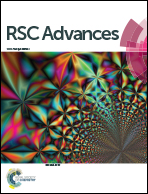Systematic exploration of N, C configurational effects on the ORR performance of Fe–N doped graphene catalysts based on DFT calculations†
Abstract
Metal single-atom catalysts (MSATs), such as Fe–N coordination doped sp2-carbon matrices, have emerged as a promising oxygen reduction reaction (ORR) catalyst to replace their costly platinum (Pt) based counterparts in fuel cells. In this work, we employ density functional theory (DFT) to systematically discuss the electronic-structure and surface-stress effects of N, C configurations on Fe–N doped graphene in single and double vacancy. The formation energy (Ef) of Fe–N-gra dropped off with the increase of N atoms incorporated for both single and double vacancy groups. The theoretical overpotentials on Fe–N–C sites were calculated and revealed that moderate N-doping levels and doping configuration could enhance the ORR activity of Fe–N coordination structures in the double vacancy and that doping N atoms is not effective for ORR activity in single vacancy. By exploring the d-band centers, we found that ligand effects and surface tension effects contribute to the modification of the d-band centers of metal Fe atoms. An optimum Fe–N–C ORR catalyst should exhibit moderate surface stress properties and an ideal N, C ligand configuration. This study provides new insight into the effects of N atom doping in Fe–N-gra catalysts and could help guide the rational design of high-performance carbon-based ORR electrocatalysts.



 Please wait while we load your content...
Please wait while we load your content...